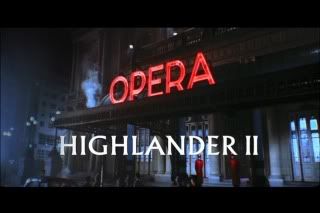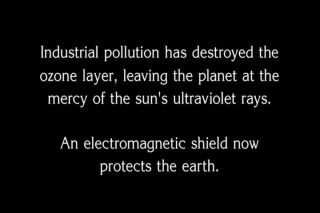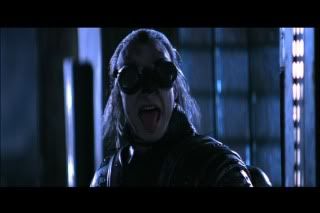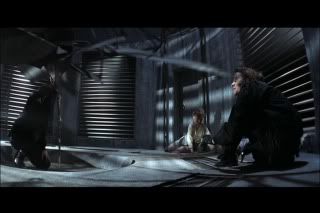
Remember those immortals in the first Highlander movie; you know, the good Highlander movie? Ever wonder why they were immortal? If you’re like me, the answer is: no. No, I’m willing to accept that there are immortals that have to kill chop off each other’s heads. I’m cool with that. In Highlander II: The Quickening, filmmaker Russell Mulcahy tried to answer the question that no one asked, and came up with this brilliant idea: all of the immortals are exiled aliens. Perfect.
Highlander II: The Quickening is just an awful, awful film. The filmmakers involved, though, were never satisfied with the final product. In 1994, Mulcahy released Highlander II: The Renegade Version, in an attempt to mulligan the first film. With a word like “renegade” in the subtitle, it was bound to attract interest; too bad it also sucked. The major change in the Renegade version is the editing around the origin of the Immortals: no longer are they aliens from another planet, but instead come from some time in Earth’s distant past. Instead of being exiled to Earth, they’re exiled to the future. Now, I see the attraction in this approach: now, the Immortals are no longer aliens. And that’s a good thing. But what the alien explanation had going for it was the simple fact that it was an explanation. Why are there immortals? Because they’re aliens, that’s why. Now, there’s still no explanation for why they’re immortals. Like with the original movie, there just are immortals--so deal with it--but now there’s the added confusion that for some reason they were sent to the future (our present) and if they win the contest they can go back to the past and … fix history? I don’t even know. But at least they’re not aliens, right?
Not satisfied with this cut, either, in 2004 Mulcahy and his crew revisited Highlander II for (please God) the last time, adding new visual effects, which augment the visual appeal of the film, and do nothing for the story. This latest edition is called Highlander II: Special Edition, and it makes one wonder where the fuck Mulcahy keeps getting money to put into this film.

The basic story goes like this: it’s 2024, Connor MacLeod, once immortal, is now an old man, and the world has gone to shit. Then immortals from “the past” arrive to fight him, and he’s young again, so he and Louise Marcus (Virginia Madsen) team up to take down the evil Shield Corporation. That’s the sensible part, at least.
The film seems to have a thing or two to say about wealth and capital. The first Highlander begins, rather memorably (for me, at least) with Connor MacLeod (Christopher Lambert) watching the Fabulous Freebirds wrestle at Madison Square Garden. This film, on the other hand, opens up at the opera. I would say that this is a clever contrast, on the part of the writers--one way of showing MacLeod’s movement up the social ladder--but if I remember correctly, MacLeod was independently wealthy way back in the 80s anyway. Still, plunk Christopher Lambert into a tux and put him at the opera, and the audience gets the idea pretty quickly: MacLeod is now important, and rich(er). Ramirez’s return comes during a performance of Hamlet, and a scene excised from the original script was set at “an elaborate wine-tasting sequence” (according to wikipedia). One can only lament the change from Queen and the Freebirds to Wagner and Shakespeare.
The narrative itself takes place in 2024. We are told that industrial pollution has destroyed the ozone layer, which has been replaced by “the shield,” an electro-magnetic field designed by MacLeod to act as an artificial ozone layer. Remember the ozone layer? It was big news in the 90s. Or at least the holes in it were. We don’t hear much about the ozone layer anymore. I think it’s because doing something about it was too hard, and thinking about it was too depressing. But I digress. The shield is controlled by The Shield Corporation, which charges for maintaining the shield. We soon learn that ozone levels above the shield have returned to normal (though it’s not explained how--perhaps this ozone layer was banished to the future from Earth’s past?), but that the Shield Corporation keeps the shield in place to keep taxing the people. Corporations are bad. It shouldn’t surprise anyone, then, that when the evil General Katana (Michael Ironside, who seems less like a samurai than his name would imply) comes to the future, he soon becomes best buds with the head of Shield Corp (John C. McGinley).

Since Louise Marcus is an eco-terrorist, she begins as a promising prospect for a strong female lead. That doesn’t last long. As soon as she confronts MacLeod, he’s attacked by some weird hedgehog-men, sent from his home planet, er, the past by General Katana, his nemesis. I guess they had hedgehog-men in the past. Soon, MacLeod is demonstrating his value to Marcus by expertly beheading both men; impressed by his new looks (MacLeod is re-immortaled by their presence, and becomes younger) and his prowess with the broadsword, Marcus immediately begins to make out with, and dry-hump, MacLeod. Having thus engaged physically with Marcus, MacLeod begins to nurture dependence by explaining how there can be only one, and it’s him, babe. Thus, within five minutes of meeting Marcus, MacLeod is already half way through the D.E.N.N.I.S System.
Of course, it wouldn’t be a Highlander movie without Ramirez, the only actor in the film played by an actual Scotsmen (Sean Connery), even if he’s portraying a Spaniard. Who is really an Egyptian. Who is really an … alien? Anyway, Connery returns, for, as Mulcahy explains in the extra features, no one would finance it otherwise. He returns to modern day Scotland, I guess because he was killed there, but since he’s a Scottish actor he fits right in. Then, he flies to America, hooks up with McLeod and Marcus, and sacrifices himself to save them from a giant fan. It’s kinda like how Obi-wan Kenobi sacrifices himself to save Luke and Han and the gang, except in this instance he’s saving the heroes from a giant fan, and not Darth Vader.

Highlander II has had about as many do-overs as Ridley Scott’s Bladerunner. The major difference is that Scott keeps improving on a great film. Mulcahy, on the other hand, has taken a massive pile of shit, and through re-editing, new special effects, and other bits of movie magic, has managed to turn it into a slightly smaller pile of shit.
If there is any upside to this film, it's the presence of Sean Connery. I'd love to praise Christopher Lambert, but let's face it, he's a pretty terrible actor. The weird thing is, though, that his presence almost guarantees that I'll enjoy the film. Highlander II: Special Edition, is one of those movies that actually fits the "so bad it's good" label. Really, I spent the entire film laughing my ass off, and whether that was intentional or not, it meant that I had a great time.
Word is that Hollywood is rebooting the Highlander franchise. I say, let 'em. Sure, some people will claim that a Hollywood re-imagining will devalue the Highlander series, but I say that the series was doing a pretty good job of that itself (see also: Star Trek).

































































